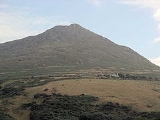
Carn Fadryn
Encyclopedia
Garn Fadryn is a five-hectare
Iron Age
hill fort
and is the name of the hill
on which the fort is situated. It lies in the centre of the Llŷn Peninsula
, Gwynedd
, and overlooks Garnfadryn village in Wales (United Kingdom).
There seems to be two phases of ancient hillfort building on Garn Fadryn, followed by a mediæval fortification
of the summit. The first period of fortification at Garn Fadryn dates from about 300 BC, when the summit and an area of some 12 acres (48,562.3 m²) were enclosed.
These were re-fortified during a second period and a wider area towards the north of a total of about 26 acres (105,218.4 m²) was enclosed. This second period of reinforcement dates from about 100 BC.
The third fort which strengthens the natural crag near the summit is thought to be "the castle of the sons of Owain", mentioned in 1188 as being newly built. (Giraldi Cambrensis Opera
(Rolls series
, 1868), VI, p123 'dua castra lapidea de nova sita fuerunt; unum...Deutrait; alterum...in capite Lhein, quod erat filium Oenei, cui nomen Karnmadrun.')
On a clear day, the view from Garn Fadryn takes in Anglesey
, Snowdonia
, most of Cardigan Bay
and even the Wicklow Mountains
in Ireland
.
Hectare
The hectare is a metric unit of area defined as 10,000 square metres , and primarily used in the measurement of land. In 1795, when the metric system was introduced, the are was defined as being 100 square metres and the hectare was thus 100 ares or 1/100 km2...
Iron Age
Iron Age
The Iron Age is the archaeological period generally occurring after the Bronze Age, marked by the prevalent use of iron. The early period of the age is characterized by the widespread use of iron or steel. The adoption of such material coincided with other changes in society, including differing...
hill fort
Hill fort
A hill fort is a type of earthworks used as a fortified refuge or defended settlement, located to exploit a rise in elevation for defensive advantage. They are typically European and of the Bronze and Iron Ages. Some were used in the post-Roman period...
and is the name of the hill
Hill
A hill is a landform that extends above the surrounding terrain. Hills often have a distinct summit, although in areas with scarp/dip topography a hill may refer to a particular section of flat terrain without a massive summit A hill is a landform that extends above the surrounding terrain. Hills...
on which the fort is situated. It lies in the centre of the Llŷn Peninsula
Llŷn Peninsula
The Llŷn Peninsula extends into the Irish Sea from north west Wales, south west of the Isle of Anglesey. It is part of the modern county and historic region of Gwynedd. The name is thought to be of Irish origin, and to have the same root Laigin in Irish as the word Leinster...
, Gwynedd
Gwynedd
Gwynedd is a county in north-west Wales, named after the old Kingdom of Gwynedd. Although the second biggest in terms of geographical area, it is also one of the most sparsely populated...
, and overlooks Garnfadryn village in Wales (United Kingdom).
There seems to be two phases of ancient hillfort building on Garn Fadryn, followed by a mediæval fortification
Fortification
Fortifications are military constructions and buildings designed for defence in warfare and military bases. Humans have constructed defensive works for many thousands of years, in a variety of increasingly complex designs...
of the summit. The first period of fortification at Garn Fadryn dates from about 300 BC, when the summit and an area of some 12 acres (48,562.3 m²) were enclosed.
These were re-fortified during a second period and a wider area towards the north of a total of about 26 acres (105,218.4 m²) was enclosed. This second period of reinforcement dates from about 100 BC.
The third fort which strengthens the natural crag near the summit is thought to be "the castle of the sons of Owain", mentioned in 1188 as being newly built. (Giraldi Cambrensis Opera
Giraldus Cambrensis
Gerald of Wales , also known as Gerallt Gymro in Welsh or Giraldus Cambrensis in Latin, archdeacon of Brecon, was a medieval clergyman and chronicler of his times...
(Rolls series
Rolls Series
The Rolls Series, official title The Chronicles and Memorials of Great Britain and Ireland during the Middle Ages, is a major collection of British and Irish historical materials and primary sources, published in the second half of the 19th century. Some 255 volumes, representing 99 separate...
, 1868), VI, p123 'dua castra lapidea de nova sita fuerunt; unum...Deutrait; alterum...in capite Lhein, quod erat filium Oenei, cui nomen Karnmadrun.')
On a clear day, the view from Garn Fadryn takes in Anglesey
Anglesey
Anglesey , also known by its Welsh name Ynys Môn , is an island and, as Isle of Anglesey, a county off the north west coast of Wales...
, Snowdonia
Snowdonia
Snowdonia is a region in north Wales and a national park of in area. It was the first to be designated of the three National Parks in Wales, in 1951.-Name and extent:...
, most of Cardigan Bay
Cardigan Bay
Cardigan Bay is a large inlet of the Irish Sea, indenting the west coast of Wales between Bardsey Island, Gwynedd in the north, and Strumble Head, Pembrokeshire at its southern end. It is the largest bay in Wales....
and even the Wicklow Mountains
Wicklow Mountains
The Wicklow Mountains form the largest continuous upland area in Ireland. They occupy the whole centre of County Wicklow and stretch outside its borders into Counties Carlow, Wexford and Dublin. Where the mountains extend into County Dublin, they are known locally as the Dublin Mountains...
in Ireland
Ireland
Ireland is an island to the northwest of continental Europe. It is the third-largest island in Europe and the twentieth-largest island on Earth...
.

